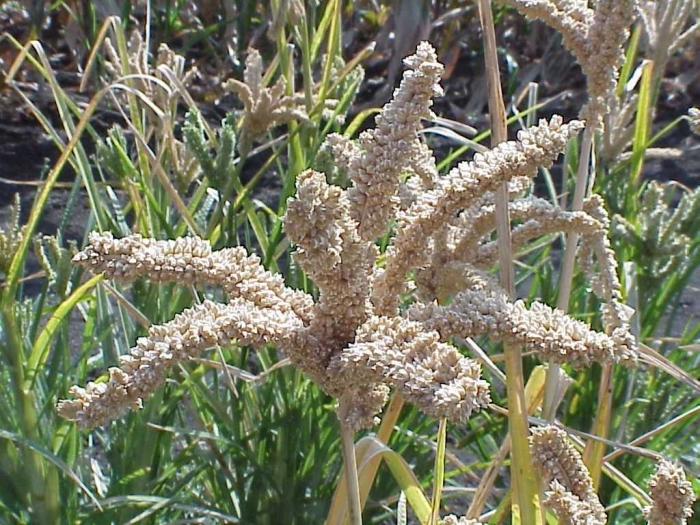Finger Millet
(Eleusine coracana)
Finger Millet (Eleusine coracana)
/
/

mage taken by J. Wilson, USDA-ARS while in Ethiopia in 2002.
Public domain
Image By:
mage taken by J. Wilson, USDA-ARS while in Ethiopia in 2002.
Recorded By:
Copyright:
Public domain
Copyright Notice:
Photo by: mage taken by J. Wilson, USDA-ARS while in Ethiopia in 2002. | License Type: Public domain | License URL: https://creativecommons.org/public-domain/ | Uploader: Atum | Publisher: Wikimedia Commons | Title: Finger_millet_3_11-21-02.jpg | Notes: |
























Estimated Native Range
Summary
Eleusine coracana, commonly known as finger millet and regionally referred to as ragi in India and kodo in Nepal, is an annual herbaceous plant. It is primarily cultivated as a cereal crop in the arid and semi-arid regions of Central and East Africa, as well as in Asia. This crop is notable for its resilience, as it can grow at altitudes over 2000 meters above sea level, has a high drought tolerance, and the grains can be stored for extended periods without spoilage. Finger millet has a robust root system and produces slender, erect, tillering stems with narrow, green leaves. The inflorescences are finger-like spikes, giving the plant its common name. The grains are small and round, typically a reddish-brown color.
Finger millet is valued for its nutritional content, particularly its high calcium and iron levels, making it an important food source in regions where it is grown. It is processed into flour and used to make various traditional dishes such as cakes, puddings, and porridge. In cultivation, finger millet thrives in full sun and is adaptable to a range of soil drainage conditions, from slow to fast. It requires medium amounts of water, making it suitable for regions with limited rainfall. While it is primarily grown for food, finger millet’s rapid growth and ability to cover the ground quickly also make it useful for controlling erosion.CC BY-SA 4.0
Finger millet is valued for its nutritional content, particularly its high calcium and iron levels, making it an important food source in regions where it is grown. It is processed into flour and used to make various traditional dishes such as cakes, puddings, and porridge. In cultivation, finger millet thrives in full sun and is adaptable to a range of soil drainage conditions, from slow to fast. It requires medium amounts of water, making it suitable for regions with limited rainfall. While it is primarily grown for food, finger millet’s rapid growth and ability to cover the ground quickly also make it useful for controlling erosion.CC BY-SA 4.0
Plant Description
- Plant Type: Grass
- Height: 2-4 feet
- Width: 2-3 feet
- Growth Rate: Moderate
- Flower Color: N/A
- Flowering Season: Summer
- Leaf Retention:
Growth Requirements
- Sun: Full Sun
- Water: Medium
- Drainage: Slow, Medium, Fast
Common Uses
Edible*Disclaimer: Easyscape's listed plant edibility is for informational use. Always verify the safety and proper identification of any plant before consumption., Low Maintenance
Natural Habitat
Arid and semi-arid regions of Central and East Africa, and Asia
Other Names
Common Names: Ragi, Kodo, 穇子;穇
Scientific Names: , Eleusine coracana, Eleusine coracana subsp. coracana, Eleusine tocussa, Eleusine rigida, Eleusine coracana var. stricta, Cynosurus coracanus, Eleusine indica var. coracana, Eleusine stricta, Cynodon coracanus
GBIF Accepted Name: Eleusine coracana (L.) Gaertn.